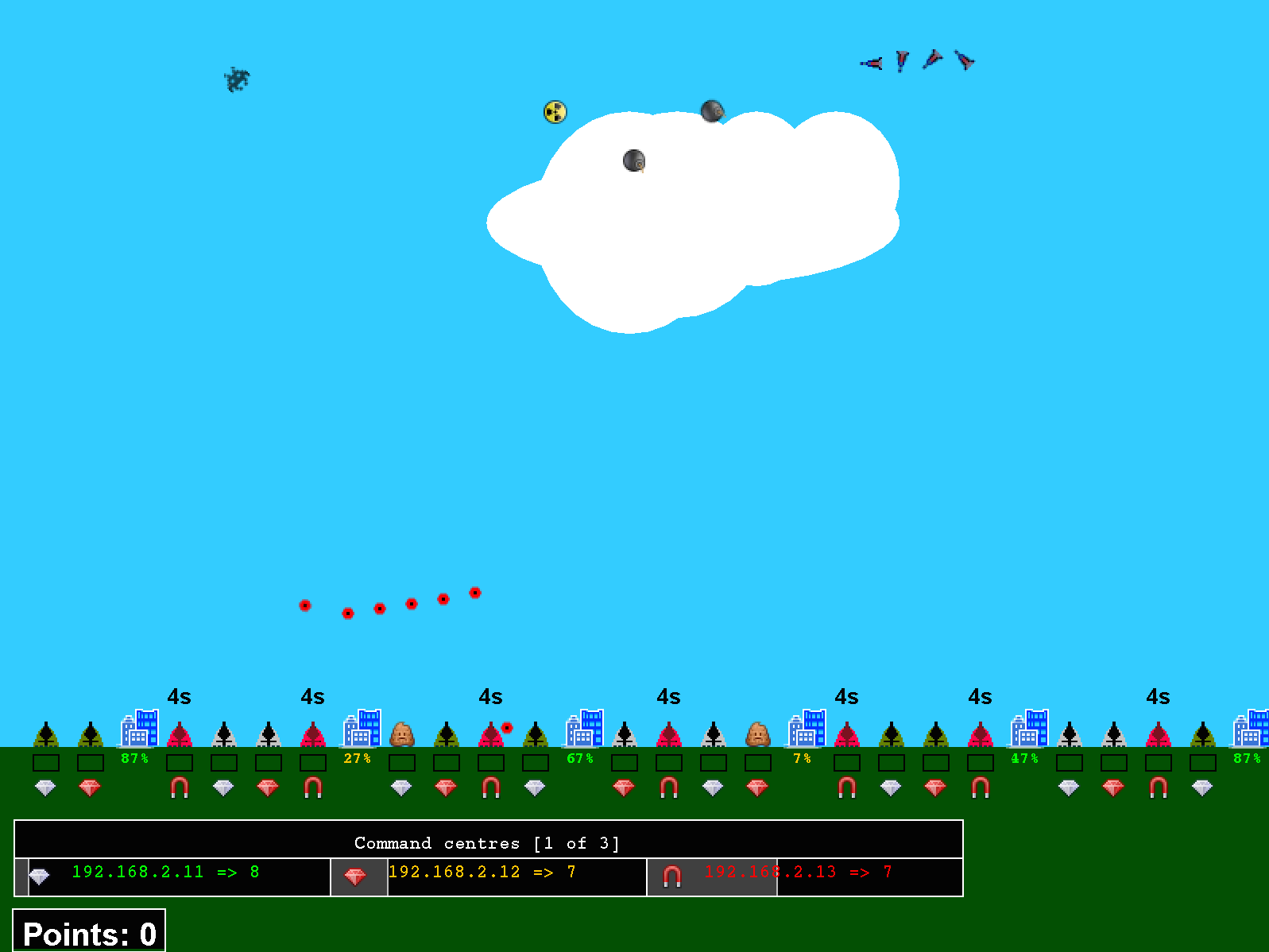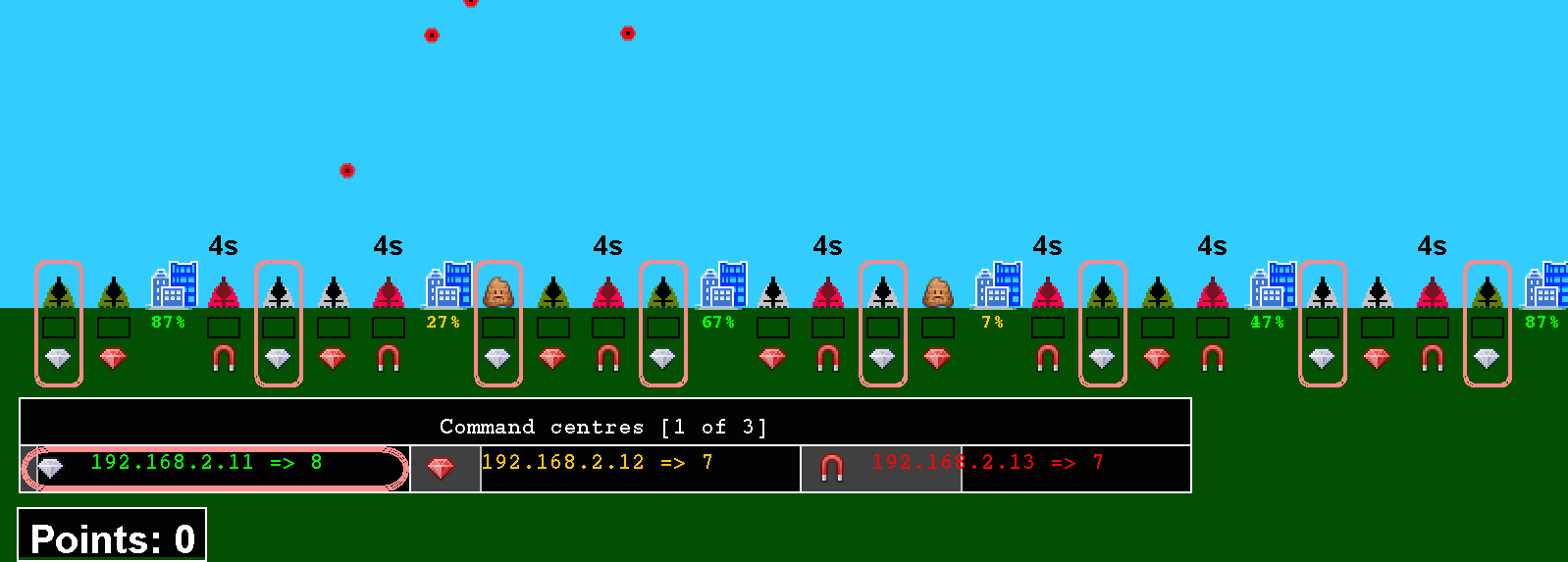Reactive Missile Defend is an application to demonstrate how Akka Cluster (Sharding and Singleton) works in stressful situation like network or power problem. The application is simulation of missile defence system. To intercept enemy missiles/bombs we are using missile towers. Every tower is seperate instance of Akka actor. These actors are distributed on many nodes. You can kill one of nodes and watch how actors are migrated.
Game looks like this:
Recording from talk is available Scala by the bay youtube channel
Our defence missile towers (one actor per each) and command centers (cluster nodes on which tower actors are run).
Towers can be in state:
![]() Realoding after firing missile
Realoding after firing missile
![]() Offline - UI does not receive message from this tower for more than 500ms
Offline - UI does not receive message from this tower for more than 500ms
![]() Infected by enemy virus, cant fire missile.
Infected by enemy virus, cant fire missile.
Command centers cluster nodes with started Sharding for TowerActor. Command centers are displayed in form:
IP => number of tower actors running
In case of running on local host:
PORT => number of tower actors running
Under the tower is an icon. This icon represent one of command centers. It visualize on which node tower actor is running. Move mouse cursor on command center and towers will be highlighted.
And can be in color:
- Green - node is up and running
- Orange - Akka cluster detects that node is unreachable.
- Red - Akka cluster removes node from cluster or node has left cluster
![]() Alien missile - fast, small radius and low damage
Alien missile - fast, small radius and low damage
![]() Bomb - slow small radius and medium damage
Bomb - slow small radius and medium damage
![]() Virus - Infect defence towers, move actor to Infected state for a few second. In this state tower can't shoot (actor is ingoring messages)
Virus - Infect defence towers, move actor to Infected state for a few second. In this state tower can't shoot (actor is ingoring messages)
Slides from Krakow Scala User Group
Cluster should have following nodes:
- Swing UI with Game engine (sbt ui)
- Command centers to run defence tower logic (choosing target and calculating interception vector) (sbt cc)
- Optional CLI UI (sbt cliui)
This project uses Cassandra 2 or 3 as a persistence. You can run cassandra using Docker or connect to existing Cassandra cluster. Details of Cassandra docker image can be found here. Two keyspaces will be created:
- rmd_journal - for journal
- rmd_snapshot - for snapshots These keyspaces can be deleted between running game.
docker pull cassandra:3.1
docker run -d -p 9042:9042 --name cass cassandra:3.1
If you are Windows or OSX user you have to add port forwarding for port 9042.
By default Cassandra host is 127.0.0.1
export=CASSANDRA_HOST=myIp
First start Cassandra which will be used as a persitence for Actors. You can run Cassadnra using docker or downloaded binaries.
Run Swing UI. This node is also game engine. Do not kill it. In terminal run
export SEED_NODE=akka.tcp://defend@127.0.0.1:3000export SEED_NODE2=akka.tcp://defend@127.0.0.1:4000export HOST=127.0.0.1export PORT=3000export CASSANDRA_HOST=myhostsbt ui
Run Command Line UI node (at least one). Every instance need to have different PORT. It can be used to observe Cluster Singleton migration / failover.
export SEED_NODE=akka.tcp://defend@127.0.0.1:3000export SEED_NODE2=akka.tcp://defend@127.0.0.1:4000export HOST=127.0.0.1export PORT=4000export CASSANDRA_HOST=myhostsbt cliui
Run Command Centers nodes (as many as you want, at least 1). Every instance need to have different PORT
export SEED_NODE=akka.tcp://defend@127.0.0.1:3000export SEED_NODE2=akka.tcp://defend@127.0.0.1:4000export HOST=127.0.0.1export PORT=2501export CASSANDRA_HOST=myhostsbt cc
In UI choose click "Start" to begin invasion. When attack is running you can kill or restart Command centers node and watch what will happened.
Enjoy
First build runnable application by sbt clean universal:packageBin. Result of build will be zip file missiledefend-x.y.z.zip in target/universal/
Use ./missiledefend-x.y.z/bin/missiledefend to run application (with arg ui for UI, cc for command center node.
You have to also export following env variables:
HOST- IP address used for communicationPORT- Port numberSEED_NODE- Akka seed node for example:akka.tcp://defend@192.168.0.3:3000SEED_NODE2- Second Akka seed node for example:akka.tcp://defend@192.168.0.3:4000CASSANDRA_HOST- Contact point for Cassandra, default value is 127.0.0.1
Start nodes:
missiledefend ui- UI - This node will host StatusKeeper actor (Cluster Singleton)missiledefend cliui- Command line UI - This node will host StatusKeeper actor (Cluster Singleton)missiledefend cc- Command Center to host defence towersmissiledefend cc- Another Command Center on another machine
- Start cluster
- Start game
- Kill one of "Command Center" JVM
- Wait for towers to be migrated and node to be disconnected (change color to red)
- Restart JVM
- Wait for node to be connected again
- Start cluster with one Command Center node on remote machine
- Disconnect network on remote machine
- Wait for towers to be migrated and node to be disconnected (change color to red)
- Connect network again, node will not be connected again.
- Restart JVM, node will be connected again
- Start cluster
- Start game
- Kill Cassandra
- Watch problems of Tower Actors (Sharding depends on persistence)
- Restart Cassandra
- Situation should go back to normal after while (if outage was short, less than ~30s)
- Start cluster with one Command Center node on remote machine
- Use "iptable" to drop 1%, 2%, 5%, 10% of traffic using iptables command:
iptables -A INPUT -m statistic --mode random --probability 0.2 -j DROP iptables -A OUTPUT -m statistic --mode random --probability 0.2 -j DROP - Watch how cluster behaves
- Start cluster
- Start game
- Right click on one of command centers, select "Cluster leave"
- Watch migration time
- Restart node
- Run "Cluster leave again"
-
Start cluster with 2 "Command Center" nodes
-
Start game
-
Click on one of the towers, it's name should be displayed.
-
Kill "Command Center" on which selected tower is running
-
Wait for towers to be migrated and node.
-
Kill cluster
-
On Ui under the tower will be displayed icon
 . Number under the icon shows how many messages are lost. In case the messages were delivered in wrong order, system also detect message lost.
. Number under the icon shows how many messages are lost. In case the messages were delivered in wrong order, system also detect message lost.Code is available under Apache Commons 2.0 License Icons are available under a Creative Commons Attribution 3.0 License. Most icons are downloaded from http://p.yusukekamiyamane.com/

